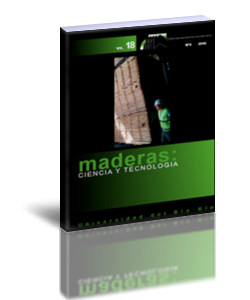Decay resistance, thermal degradation, tensile and flexural properties of sisal carbon hybrid composites
Keywords:
Coniophora puteana, mechanical properties, modulus of elasticity, modulus of rupture, Pinus sylvestris, thermogravimetric analysis, Trametes versicolor.Abstract
Sisal-carbon hybrid composites were produced from mixtures having different weight ratios of sisal, carbon fibers and recycled polypropylene. All formulations were tested and evaluated for tensile and flexural properties. In addition, the thermal stability of the sisal-carbon hybrid composites were examined via thermogravimetric analysis and decay tests were conducted to determine the degradation of the hybrid composites. Results showed that the biological durability and mechanical and thermal properties improved with the increasing weight ratios of carbon fiber in the hybrid composites. According to the mechanical tests, the optimum hybrid composite formulation was found to be 12% sisal fiber + 28% carbon fiber + 60% rPP.Downloads
References
Abu, B.H.A.; Abdul, K.H.P.S. 2005. Lignocellulose-based hybrid bilayer laminate composite. Part 1: studies on tensile and impact behavior of oil palm fiber-glass fiber- reinforced epoxy resin. J Compos Mater 39:663-684.
ASTM D 638. 2004. Standard Test Method for Tensile Properties of Plastics. American Society for Testing and Materials. West Conshohocken, PA. 08 (01).
ASTM D 790. 2004. Flexural Properties of Unreinforced and Reinforced Plastics and Electrical Insulating Materials. American Society for Testing and Materials. West Conshohocken, PA. 08 (01).
Bajracharya, R.M.; Manalo, A.C.; Karunasena, W.; Lau, K. 2014. An Overview of Mechanical Properties and Durability Of Glass-Fibre Reinforced Recycled Mixed Plastic Waste Composites. Materials and Design 62:98-112.
Caulfield, D.F.; Clemons, C.; Jacopson, R.E.; Rowell, R.M. 2005. Handbook of wood chemistry and wood composites. Taylor & Francis. London, New York, Singapore, p. 365.
Clemson, C.M.; Ibach, R.E. 2004. Effects of processing method and moisture history on laboratory fungal resistance of wood-HDPE composites. Forest Prod J 54(4):50-57.
EN 113. 1996. Test method for determining the protective effectiveness against wood destroying basidiomycetes. Determination of the toxic values. European Committee for Standardization, Brussels.
Haneefa, A.; Bindu, P.; Aravind, I.; Thomas, S. 2008. Studies on tensile and flexural properties of short banana/glass hybrid fibre reinforced polystyrene composites. J Compos Mater 42:1471-1489.
Indicula, M.; Malhotra, S.K.; Joseph, K.; Thomas, S. 2005. Dynamic mechanical analysis of randomly oriented intimately mixed short banana/sisal hybrid fibre reinforced polyester composites. Compos Sci Technol 65:1077-1087.
Jarukumjorn, K.; Suppakarn, N. 2009. Effect of glass fiber hybridization on properties of sisal fiber- polypropylene composites. Composites: Part B 40:623-927.
Khanam, P.N.; Khalil, H.P.S.A.; Jawaid, M.; Reddy, G.R.; Narayana, C. S.; Naidu, S.V. 2010. Sisal/ Carbon fibre reinforced hybrid composites: Tensile, flexural and chemical resistance properties. J Polym Environ 18:727-733.
Kim, S.S.; YU, H.N.; Hwang, I.U.; Lee, D.G. 2008. Characteristics of wood–polymer composite for journal bearing materials. Compos Struct 86:279-284.
La Manita, F.P.; Morreale, M.; Ishak, Z.A. 2005. Processing and mechanical properties of organic filler-Polypropylene composites. J Appl Polym Sci 96:1906-1913.
Mallick, P.K. 2008. Fiber reinforced composites: material, manufacturing and design. 3rd ed. CRC Press, New York.
Matuana, L.M.; Park, C.P.; Balatinecz, J.J. 1998. Cell morphology and property relationships of microcellular foamed PVC/Wood-fiber composites. Polym Eng Sci 38:1862-1872.
Moreno, P.; Rodrigue, D.; Giroux, Y.; Ballerini, A.; Gacitua, W. 2013. Morphological and mechanical characterization of recycled thermoplastic foams reinforced with wood sub-products. Maderas-Cienc Tecnol 15(1):3-16.
Morris, P.I.; Cooper, P. 1998. Recycled plastic/wood composite lumber attacked by fungi. Forest Prod J 48(1):86-88.
Nourbakhsh, A.; Ashori, A. 2010. Wood plastic composites from agro-waste materials: Analysis of mechanical properties. Bioresource Technol 101:2525-2528.
Paiva, J.M.F; Santos, A.N; Rezende, M.C. 2009. Mechanical and morphological characterizations of carbon fiber fabric reinforced epoxy composites used in aeronautical field. Mater Res 2(3):367-374.
Ramesh, M.; Palanikumar, K.; Reddy, K.H. 2013. Comparative evaluation on properties of hybrid glass fiber-sisal/jute reinforced epoxy composites. Procedia Engineering 51:745-750.
Samal, S. K.; Mohanty, S.; Nayak, S. K. 2009. Polypropylene–bamboo/glass fiber hybrid composites: Fabrication and analysis of mechanical, morphological, thermal, and dynamic mechanical behavior. J Rein Plas Comp 28(22):2729-2747.
Sharma, M.; Gao, S.; Mader, E.; Sharma, H.; Wei, L.Y.; Bijwe, J. 2014. Carbon fiber surfaces and technology. Comp Sci Tech 102:35-50.
Thwe, M. M.; Liao, K. 2003. Environmental effects on bamboo–glass/polypropylene hybrid composites. Journal of Materials Science 38(2): 363-376.
Tufan, M.; Akbaş, S.; Güleç, T.; Taşçioğlu, C.; Alma, M.H. 2015. Mechanıcal, Thermal,
Morphological Properties And Decay Resıstance Of Filled Hazelnut Husk Polymer Composites. Maderas-Cienc Tecnol 17(4):865-874.
Verhey, S.A.; Laks, P.E. 2002. Wood particle size affects the decay resistance of woodfiber/ thermoplastic composites. Forest Prod J 52(11/12):78-81.

































